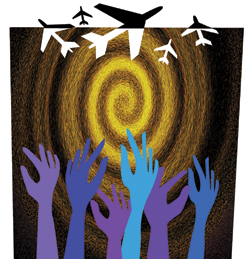INDIAN ARMED FORCES CHIEFS ON OUR RELENTLESS AND FOCUSED PUBLISHING EFFORTS

The insightful articles, inspiring narrations and analytical perspectives presented by the Editorial Team, establish an alluring connect with the reader. My compliments and best wishes to SP Guide Publications.

"Over the past 60 years, the growth of SP Guide Publications has mirrored the rising stature of Indian Navy. Its well-researched and informative magazines on Defence and Aerospace sector have served to shape an educated opinion of our military personnel, policy makers and the public alike. I wish SP's Publication team continued success, fair winds and following seas in all future endeavour!"

Since, its inception in 1964, SP Guide Publications has consistently demonstrated commitment to high-quality journalism in the aerospace and defence sectors, earning a well-deserved reputation as Asia's largest media house in this domain. I wish SP Guide Publications continued success in its pursuit of excellence.
- The layered Air Defence systems that worked superbly, the key element of Operation Sindoor
- Operation Sindoor | Day 2 DGMOs Briefing
- Operation Sindoor: Resolute yet Restrained
- India's Operation Sindoor Sends a Clear Message to Terror and the World – ‘ZERO TOLERANCE’
- Japan and India set forth a defence cooperation consultancy framework, talks on tank and jet engines
Affordable Air Travel a Fading Dream

The one debilitating factor that completely transformed the dynamics of aviation is the price of ATF. To stop the haemorrhage, airlines will have to raise fares substantially—once again pushing air travel to realms beyond the reach of the common man.
Three years was the expected period for airlines in the private sector to break even from the time of commencement of operations. But as all but one airline, licenced this year, complete three years of operations, profitability seems to have become a fading dream. In a fiercely competitive environment, airlines in India have been caught in a tightrope traipse—striving to maintain a fine balance between unreasonably high input costs in India and the need for an attractive fare structure to ensure a respectable load factor.
Within a few months of launching operations, Indus Airways downed shutters even as Air Sahara and Deccan threw in the towel and were acquired by the relatively more stable Jet Airways and Kingfisher Airlines, respectively. Analysts described these events as consolidation and shakeout in the industry, both characterised by a degree of inevitability.
Merger of Air India and Indian, orchestrated by the government for considerations somewhat similar to those of the private airlines, is yet to be completed. Teetering under staggering losses and mounting financial burden, Air India is seeking a bailout package of Rs 2,300 crore from the government if only to stay afloat. Kingfisher Airlines, meanwhile, is reported to have accumulated heavy losses in its effort at brand-building even before ATF prices went through the roof. By March 2009, cumulative losses of all airlines together are expected to touch the estimated figure of a staggering Rs 10,000 crore.
Juggling survival strategies, airlines were dealt a devastating blow by the unprecedented rise in the international price of oil that peaked at nearly $150 a barrel. There was a corresponding rise in the price of aviation turbine fuel (ATF) and in the tax burden, which in India is perhaps higher than anywhere else in the world. Cost of fuel as a component of operating cost thus rose from 30 to 50 per cent in the course of a year, throwing all calculations out of gear and plunging the industry into major crises. Two other events fuelled the distress: an economic slowdown in India and several US airlines succumbing to the turmoil in the American economy.





